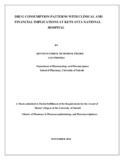| dc.description.abstract | Background: Medicines costs constitute 20% to 40% of health budgets in many developing countries. This study sought to conduct an analysis of drug use in Kenyatta National hospital using various tools namely ABC and VEN analyses and drug use evaluation (DUE). The overall goal of the study was to contribute to improved and cost effective drug therapy in the hospital by identifying, documenting and analyzing problems in drug utilization and thus contributing towards the rational use of medicines in the institution. .
Objective: The main objective of the study was to investigate the drug consumption patterns, their cost and clinical implication at Kenyatta National Hospital over a period of 3 years (2013-2015).
Method: For the ABC analysis, annual consumption and expenditure data for each year from 2013 to 2015, was extracted from the records at Kenyatta National hospital (KNH) Pharmaceutical stores. This was followed by classification of each of the drugs into the three ABC categories based on their individual annual expenditure. The drugs were also classified into the three VEN categories (Vital, Essential & Non-Essential) based on their public health importance. The VEN classification for drugs in this study was based on the KNH formulary and the Kenya Essential Medicine List 2010 (KEML) VEN categories. Therapeutic categories were identified based on the KNH formulary and the International Classification of Diseases (ICD) and expenditure for each category calculated. Morbidity data was extracted from the Health information records and compared with the annual expenditures for each therapeutic category. From the ABC analysis, one drug suspected to be used irrationally and which had high annual usage expenditure and which was also critical in the hospital was identified for further evaluation. For this purpose Meropenem injection was selected and with the approval of the hospital Drug and therapeutic committee (DTC) a drug use evaluation (DUE) on Meropenem was conducted. The DUE was a retrospective observational study which reviewed medical records of admitted patients based on criteria which were developed before conducting the DUE.
Results: For the ABC analysis, the study analyzed expenditure on an average of 811 drugs for each year (2013-2015). After analysis, the study showed that 13.2% (107), 13.6% (110) and 14.2% (115) of the drugs belonged to Class A for the three years respectively. These drugs consumed 79.9% of the drug budget for 2013 and 2014 and 79.8% for 2015. Class C drugs represented the
xvi
highest number of drugs at 576 (70.9%), 566 (69.8%) and 558 (68.8%) for the three years (2013-2015) but these drugs consumed only an average of 5% of the total expenditure on medicines. VEN categorization of the drugs showed that vital and essential medicines consumed the highest percentage of the total expenditure on medicines. ABC-VEN matrix analysis showed that an average of 31% (252) drugs belonged to category I and these drugs consumed an average of 85% of the total expenditure on drugs. Therapeutic category and morbidity patterns showed that out of the 14 categories considered for this study, there was a mismatch between morbidity (% number of cases) and overall expenditure for 12 categories and only two categories matched their percentage expenditures to the percentage number of cases. The DUE revealed that only three out of the eleven criteria met the pre-set threshold of 95%. Most of the Meropenem prescriptions were empirical at (61.3%) and the most common diagnoses were sepsis, pneumonia and meningitis at 26.1%, 17.1% and 15.3% respectively.
Discussion and Conclusion: The study helped to evaluate expenditure on medicines (ABC analysis) against their therapeutic importance (VEN analysis) and disease patterns in the hospital hence identifying probable drug use problems. Overall, there were differences between disease patterns/clinical need and expenditure on the various categories of medicines which should be addressed by the hospital. Moreover, having identified drugs with the highest expenditures (Category A of the ABC analysis), recommendations will be made to the hospital for institution of stricter controls in their use and inventory management including data driven quantification and tighter control on stocking levels in order to control and rationalize drug inventory costs. In addition, the study recommends that the lion share of the hospital budget should be directed to the procurement of Vital and essential drugs as these drugs address the majority and key public healthcare needs and morbidity patterns. The categorization of drugs in ABC-VEN matrix helped to identify the category I drugs which are Vital and expensive and these require efficient management as they will aid in improving patient care and the use of the limited resources
The DUE revealed failure in the use of Meropenem to meet of most of the established criteria as per the pre-set thresholds. The results highlights the need to promote adherence to drug use protocols which would ultimately improve the rational use of medicines including the need for culture and sensitivity testing for selected antibiotics where recommended, despite the financial
xvii
burden of such tests on patients. However, empirical use of antibiotics such as Meropenem may be justified in the initial treatment of serious infections where early initiation of therapy is recommended. In this study, the most common diagnosis where Meropenem was used were sepsis, pneumonia and meningitis, and since these are serious infections, the high empirical use of Meropenem at 65.3% may have been justified.
The Therapeutic category and Morbidity pattern analysis showed that there were differences between percentage of drug expenditure and percentage number of cases. | en_US |
| dc.description.department | a
Department of Psychiatry, University of Nairobi, ; bDepartment of Mental Health, School of Medicine,
Moi University, Eldoret, Kenya | |


